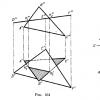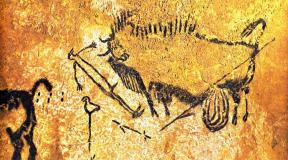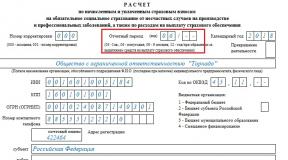What are the reasons for the successful military campaigns of the Mongols. Conquest of the Mongols. Positive and negative consequences of the Mongol conquests



Battle of the City River

fall of Kyiv. 1240

As a result of resistance, Rus' saved Western Europe. IN 1242 Batu's troops suffered heavy losses in the Czech Republic and Hungary, as a result of which they abandoned further advance to the West.
IN 1243 Batu founded the state of the Golden Horde on the Lower Volga with its capital in Sarai-Batu, which was considered a province (ulus) of the Great Mongol Empire with its center in Karakorum. Unlike China, Central Asia and Transcaucasia Russian principalities were not directly part of the Golden Horde, they were vassals(i.e. the Mongol Khan was the supreme ruler who did not interfere in their internal life). The social and political structures that existed in them were preserved (maybe this was the result of heroic resistance): princely power, local feudal lords, spiritual foundations (Orthodoxy).


Manifestation of the Horde yoke
(from Old Slavic, from Latin - yoke)
Political sphere:
- Receipt by the Russian princes from the Horde khans shortcuts to reign.
- Terror against Russian princes: destruction of undesirables, hostage taking.
- Punitive raids on Russian lands (“bloodletting”) (About 50 during the yoke), among them:
— 1251 – Nevryuev’s army (campaign to Suzdal land)

— 1258 – Burundaev’s army (campaign to the Galician land)
— 1293 g . – Dudenev’s army (14 cities of North-Eastern Rus' were devastated)

- Inciting civil strife in order to increase fragmentation ( By the middle of the 12th century, Rus' collapsed into 15 principalities. At the beginning of the 13th century, the principalities in Rus' became about 50, and in the XIV century, i.e. by the time the new unification of Rus' began - approximately 250 )
- Tightening of Russian legislation: strengthening the personal power of the Grand Duke and the lack of rights of landowners.
Economic sphere:
- · "Horde exit" Payment of annual tribute – exit (food, crafts, money, slaves)
- Requests – extraordinary payments
- Wake – gifts to the khan, his relatives, close associates
- Maintenance of the administrative apparatus, Horde ambassadors and their retinue in Russian lands
- Carrying out natural duties: transportation, construction
- Hijacking specialists and artisans into the Horde ( disappearance of a number of complex crafts, cessation of stone construction)
- Creation of privileged conditions for Horde merchants
Spiritual sphere:
- The influence of Horde foundations on everyday life and speech (the appearance in the Russian language of words of Turkic origin (“ shackles", "bondage", "whip" ), customs, morality of Russians
- Suppressing the will of the population to resist through terror
- Granting special status to the Russian Orthodox Church, the khan’s use of the Christian idea of humility to subjugate the Russians
Military sphere:
- Supply of Russian soldiers to the Mongol troops ("tribute in blood")
Consequences of the Mongol invasion and the Horde yoke for Russian lands

- Migration (relocation, movement) of the population to the northern regions
- Decline old agricultural centers and cities
- Desolation of previously developed fertile lands (Wild field)
- The destruction of cities ( from 74 Russian citiesXII-XIIIbb., 49 were devastated by Batu's hordes.14 none of them ever rose from the ruins, Amore 15 cities over time turned intosat down.) For the first time 50 years During the reign of the conquerors in Rus', not a single city was built, and the pre-Mongol level of stone construction was achieved only through 100 years after Batu's invasion.
- Numerous civilian casualties. Huge losses among the feudal elite (Death in the fight against the conquerors of many professional warriors-feudal lords - princes and warriors)
- Conservation of political fragmentation
- Introducing eastern elements into the political structure of the Moscow state: authoritarianism (system of citizenship between the prince and the nobility), strict vertical subordination, punitive apparatus, etc.)
- Slowdown in the pace of cultural development
- The weakening of Rus', the fall of its international authority (Poland, Lithuania, Hungary divided the lands of Galicia, Volyn, Transcarpathia.)
- The lag of Rus' in its development from Western Europe
- Strengthening the position and influence of the Russian Orthodox Church, which played an important role in the unity and survival of the Russian people

Relations between Rus' and the Golden Horde inXIIIV.

JarlsTo- a charter for reign, which was issued by the Mongol khan to the Russian princes.
Khan- the title of the ruler of the Mongolian and Turkic nomadic tribes.
Baskak- governor of the Mongol Khan, who collected tribute from the population of Rus'.
Yasak- tribute paid by the population of Russian principalities to the Khan of the Horde (tithe)
- a Mongol army, as well as a camp, a parking lot where the khan’s headquarters were located.
Ulus- inheritance, region, administrative-territorial unit of the Mongol Empire
Yasir- tribute paid by the population of Russian principalities by people (prisoners)
Reasons for the success of the Mongol-Tatars
What are the reasons for the successes of the Mongol-Tatars at the beginning of the conquest of Rus'? Why did the nomads, who were significantly inferior to the conquered peoples of Asia and Europe in economic and cultural development, subjugate them to their power for almost three centuries?
One of the reasons is feudal fragmentation in Rus' and weak interstate ties between the countries of Asia and Europe, which did not allow them to join forces to repel the aggression of the conquerors.
The next reason is the numerical superiority of the conquerors. Batu sent 120-140 thousand of his soldiers to Rus'. All of Rus' (even if it united) would be able to field only about 100 thousand soldiers.
And one more circumstance - military. The small number of cavalry units, the absence of a professional army, the defensive tactics of the Russian troops are tactics of exhausting the enemy. However, the Russian wooden fortresses could not withstand the continuous assault of the Mongol-Tatar troops. High-quality reconnaissance before the start of hostilities. Russian betrayal. In addition, the Mongol military leaders did not personally participate in the battles, but led the battle from their headquarters, which was, as a rule, in a high place. Russian princes up to Vasily II themselves directly participated in the battles. Therefore, very often, in the event of even the heroic death of a military prince, his warriors, deprived of professional leadership, found themselves in a very difficult situation.
Batu's attack on Rus' in 1237 was a complete surprise for the Russians. The Mongol-Tatar hordes undertook it in the winter, attacking the Ryazan principality. Ryazan residents were accustomed only to summer and autumn raids by enemies (mainly Polovtsians). Therefore, no one expected a winter attack. What did the steppe people pursue with their winter blow? The fact is that the rivers, which were a natural barrier for enemy cavalry in the summer, were covered with ice in the winter and had already lost their protective functions. In addition, food supplies and feed for livestock were prepared in Rus' for the winter. Thus, the conquerors were already provided with food for their cavalry before the attack.
These were the main strategic and tactical reasons for the victories of the Mongol-Tatars at the very beginning of their conquests.
Horde yoke in Rus'. Liberation
The Horde yoke in Rus' lasted 240 years - from 1242 to the middle of the 15th century. Finding themselves under the rule of the Mongols, the Russian princes were forced to admit that they were vassals of the rulers of the Golden Horde. Their powers had to be approved by special letters - labels. In addition to princes, metropolitans appointed in Rus' were also required to receive labels. A tribute, or “exit,” was also imposed on Russian lands. At first it was collected in the form of natural taxes, and then payments were made in silver.
Military service was also imposed on the Russian principalities: they were obliged to provide a certain number of soldiers to participate in the campaigns of the Mongol army. To supervise the Russian lands, the khan's governors, the Baskaks, were stationed in the cities. However, their presence on Russian lands caused such discontent that gradually, by the end of the 13th century, the Baskaks had to stop their activities, and the collection of tribute was entrusted to the Russian princes. In order to accurately determine the amount of tribute, the Mongols even conducted several censuses of the tax-paying population in Rus'. The first of them took place in 1257.
After establishing dependence on the Mongol Empire, the policy of the Russian princes also changed. Some of them, like Daniil Galitsky, tried to offer armed resistance to the Horde. However, such attempts more often ended in the defeat of the Russian squads.
Thus, the Golden Horde did not establish its direct rule in Rus' and did not encroach on the traditional, already established system of government of the Russian lands. The princes in Rus' were only vassals of the Golden Horde khans. The low level of socio-economic and social development of the Horde state did not allow the invaders to develop the country and create their own governing bodies in Rus'.
To strengthen their power in Rus', the Horde khans periodically carried out invasions and raids in order to achieve internal weakening of Rus' and interfere with the economic development of its territories. It was easier to maintain the Horde yoke by deepening the political fragmentation of the country, inciting strife, and pitting Russian princes against each other. And so far the Golden Horde khans have managed to accomplish this.
The outcome of the fight against the Horde was decided by the Battle of Kulikovo, which became not only a stage in the fight against the Mongol-Tatar conquerors, but also the beginning of the formation of the Russian centralized state. It occurred on September 8, 1380 on the Kulikovo field, located on the right bank of the Don at the confluence of the Nepryadva River.
The selection of the Kulikov field for battle showed Dmitry Ivanovich’s firm determination to defend Rus' at any cost. Having crossed the Don, he cut off his path for retreat and, as it were, challenged Mamai to a mortal fight. At the same time, the location of the Kulikovo Field gave the Russian troops certain advantages militarily. The main one was that the flanks of the Russian army were covered by the rivers Don and Nepryadva, which deprived the Tatar cavalry of the opportunity to use traditional tactics - enveloping the enemy from the flanks. The dense oak grove located on the left flank was used by Dmitry Ivanovich to place reserves - an ambush regiment.
The speed and secrecy with which the Russian troops approached the battlefield allowed Dmitry Ivanovich to thwart Mamai’s plans to unite with the Lithuanian troops and the squad of the Ryazan prince Oleg, who became his ally for a while. The Russian prince managed to force the Tatars to enter the battle without allies.
The Tatars began the battle, attacking the Russian regiments with all their might. A fierce battle raged for several hours. Russian soldiers steadfastly withstood the blows of the enemy hordes. However, they eventually managed to break through the Russian line, and Mamai already considered himself a winner. But at this critical moment, a Russian ambush regiment located in the oak grove was brought into battle. The unexpected appearance of fresh Russian forces decided the outcome of the battle. The Tatars wavered and fled. For almost thirty miles, Russian soldiers pursued the fleeing enemy. Contemporaries called the Battle of Kulikovo "Mamaev's Massacre", and after that Dmitry Ivanovich began to be called Donskoy. The events of this time are described in an outstanding monument of ancient Russian literature - “The Tale of the Massacre of Mamaev.”
The historical significance of the victory of the Russian troops was enormous. The defeat of Mamai meant the collapse of plans for the division of Rus'. The Battle of the Kulikovo Field showed the possibility of victory over the Tatars and became the beginning of the liberation of Rus' from the Mongol-Tatar yoke.
Standing on the Ugra River 1480 Overthrow of the Horde yoke
In the middle of the 15th century, the Golden Horde split into a number of khanates. Nevertheless, Khan Akhmat made an attempt to restore Tatar rule in Rus'. He took advantage of Lithuania's concerns about the growing independence of Rus' and negotiated military assistance with King Casimir IV. Counting on her, in the summer of 1480 Khan Akhmat set out on a “great campaign” against Moscow. But when the Tatars approached the Oka River, it turned out that the crossings across it were occupied by Moscow regiments. Akhmat did not dare to take the fight and moved along the Oka to join the troops of Casimir IV. Approaching the right bank of the Ugra River, he saw the “great Moscow army” and again did not dare to take the fight. The troops of Casimir IV never came to the aid of Akhmat, since they were busy repelling the attack of Ivan III’s ally, the Crimean Khan Mengli-Girey.
On November 11, 1480, Akhmat began a hasty retreat from Ugra. In the lower reaches of the Volga, the returning army was attacked by the combined forces of the Nogai Tatars and the Siberian Khan Ibak. During the battle, Akhmat was killed.
How many soldiers were there in the Tatar-Mongol army during the campaign against Rus'?
According to the official point of view, it took the Mongols six years to conquer Rus', and about another twenty years to bring its population into tributary dependence. But why was it necessary to invade lands that lay several thousand kilometers from the capital of the empire?
Discussion questions
There are several explanations for the western conquest of the Mongols, during which the Horde managed not only to ravage the Russian lands, but also to reach the territories of Poland and Hungary. According to one view, by subjugating the Russian principalities, the Mongols ensured the security of the western wing of their empire. Another version focuses on the Mongols’ pursuit of one of their most formidable opponents - the Cumans, who took refuge in the Hungarian lands.
There are many questions about the selective conquest of Russian cities by the Mongols. For example, why did Batu need to take Kozelsk, which was completely insignificant in strategic terms, in 1238, spending almost 2 months on its siege, while bypassing neighboring Krom, Mtsensk, Domagoshch, Kursk, Smolensk. Lev Gumilyov explains this as revenge on the grandson of the Chernigov prince Mstislav, who then ruled in Kozelsk, for the murder of ambassadors on the Kalka River in 1223. However, the Smolensk prince Mstislav the Old, also involved in this murder, somehow escaped the Horde's wrath.
Some researchers who adhere to an alternative interpretation of the events that took place in medieval Rus' generally reject such a phenomenon as the “Tatar-Mongol yoke.” Lev Gumilev, for example, believed that Rus' and the Horde were two states that coexisted side by side for several centuries and alternately gained the upper hand over each other.
Other researchers went further, arguing that Rus' and the Horde are one and the same state. In their opinion, the “Tatar-Mongol yoke” is simply a specific period in the history of the Russian state, when the entire population of the country was divided into two parts: civilians controlled by princes and a permanent regular army-Horde led by military leaders.
One way or another, any of the versions recognizes that during the XIII-XV centuries, Rus' went through a difficult period of civil strife, devastation, desolation and gathering of lands, which prepared the formation of the Russian state under the leadership of a new political center - Moscow. However, to explain why this happened, let us turn to the facts confirmed by official history.
Leader
At the end of the 12th century, a new leader appeared in Mongolia - Temujin, who very quickly subjugated the scattered nomadic tribes to his influence. Temujin had excellent command of the tactics of the steppe war, winning victory after victory. He offered defeated enemies a choice: either join him or die. The majority took the side of the commander, gradually increasing the size of his army.
By 1206, Temujin, under a new name - Genghis Khan - had become the most powerful ruler north of the Great Wall of China. The strict centralization of state and military power and the requirements for strict execution of decrees allowed him to manage the multi-million population of the nomadic empire.
Genghis Khan forced the Temniks to keep armed detachments on the outskirts of their possessions, ready at any moment to protect the lands of the Mongols from attack or to launch another punitive campaign. Soon Genghis Khan had no enemies left among the Mongol nomads, and he began to prepare for wars of conquest.
Expanding the boundaries
One of the main reasons for Mongol expansion lies in the type of statehood of the Mongols. In its structure, the Mongol Empire was a united group of nomadic pastoral tribes that were constantly in need of new pasture lands. The Don and Volga steppes in this regard were much more attractive than the Central Asian semi-deserts.
However, the Horde is not only nomadic, but also sedentary zones. Thus, under Khan Berke, the Horde founded a large number of settlements on the banks of the Volga and Don. Here there was trade in spices, fabrics, perfumes that came from the East, and from Russian lands - furs, honey, wax. The craft also developed.
Both components of the Horde economy - the nomadic steppe and the sedentary zone - supported each other and contributed to increasing the economic potential of the state. However, none of them could do without an army, which, by seizing new territories, imposing tribute on the conquered population and ensuring control over the caravan routes, created the power of the Genghisid empire.
Army
The driving force behind the successful military campaigns carried out by the nomads led by Genghis Khan was a horde of thousands. The maximum number of the Mongol army is named by the Italian Franciscan Paolo Carpini, who visited the empire of Genghis Khan - 600 thousand people. Modern historians, however, consider this figure to be clearly overestimated. So, in their opinion, from 120 to 150 thousand soldiers could take part in the campaign against Rus'.
Genghis Khan's army was distinguished by its clear organization and iron discipline. To the highest command positions, the Great Khan appointed his sons and representatives of the tribal nobility from among those military leaders who had proven their loyalty and demonstrated military valor.
One of the key roles in the victories of the Horde was played by the “despicable bow”, well known to the nomadic peoples of Central Asia, but underestimated by Europeans, including Russians. The Mongolian bow, although inferior in length to the famous English longbow, was twice as powerful as it and had a greater flight range - up to 320 meters versus 228. Western European knights were amazed that the Mongolian arrow pierced the man-at-arms if he was not covered with a shield .
The victories of the Horde were also well served by the stocky Mongolian horses, extremely hardy and unpretentious in food, which showed themselves well in the harsh conditions of the Russian thaw and northern winters. Each warrior had 5 horses with him, which gave serious advantages to the Mongols in long campaigns.
With the generally accepted strategy of close combat, the Mongol light cavalry simply did not allow the enemy to get closer, showering them with a hail of arrows. The foot Russian militia, more often armed with spears and axes than with swords and spears, had little chance of success in the battle with this formidable enemy.
The wooden fortress cities, which, under the onslaught of a wide arsenal of siege weapons used by the Horde, sooner or later capitulated, could help little in the defense of Rus'. As a rule, the matter was completed by fire, which quickly turned the recently flourishing settlements into ashes.
Under the pressure of the Horde
A kind of reconnaissance before the large-scale invasion of Rus' was the campaign of the thirty thousand army of Subedei and Jebe in Transcaucasia and South-Eastern Europe in 1222-1224, during which the famous victory of the Horde over the united Russian-Polovtsian army at Kalka in 1223 took place. During reconnaissance, the Mongols thoroughly studied the future arena of military operations, became acquainted with the capabilities of the Russian army, fortifications, and received information about the relationships between the Russian principalities.
Discussion of the next campaign of the Horde army always took place at the kurultai. Military leaders carefully chose the time of year and routes for invasion. So the attack on Rus' was planned for the winter of 1237-1238: it was taken into account that frozen rivers would greatly facilitate the movement of the Mongol cavalry and serve as ideal transport routes.
In just a few months of the first campaign, the Horde army conquered the lands of the Ryazan region and North-Eastern Rus', only 100 miles short of reaching Novgorod; two years later the Chernigov, Kiev and Galician-Volyn principalities fell. However, the Horde military leaders did not destroy everything; it was more important for them to subjugate the Russian princes and build a system of tributary dependence.
Historians call the main reason for the seizure of almost the entire territory of Rus' the disunity of the Russian principalities. Long-term civil strife could not but affect the ability of the owners of fiefdoms to unite at the decisive moment. Historian Ruslan Skrynnikov believes that the strong squad of the Novgorod prince Yaroslav Vsevolodovich could have resisted the Mongol army, but he did not want to join the defenders of the fatherland.
The low population density of Rus' became a great help for the successful advance of the Mongol army. For example, one of the largest cities of the ancient Russian state of Ryazan, according to the historian Vladislav Darkevich, had a maximum of 8 thousand inhabitants, and about 12 thousand more could live in the vicinity of the city. Even having gathered all the forces of the principality, Ryazan could not resist the Horde’s many times superior troops.
CHAPTER XII
MONGOL CONQUESTS IN THE 13th century.
One of the main events in the history of Eurasia in the 13th century, which radically influenced the historical destinies of many peoples of the continent, was the Mongol conquest. Accompanied by numerous human casualties and destruction, these conquests led to the formation of the first world-system, which united large regional economic “nuclei” (Europe, Islam, India, China, the Golden Horde), and largely determined the modern ethnic map of Eurasia, because it was precisely as a result of them Many modern peoples arose (Uzbeks, Kazakhs, Siberian, Kazan, Crimean Tatars, Nogais, Karakalpaks, Kyrgyz), and other peoples acquired a modern appearance.
ABOUT THE REASONS OF THE MONGOL CONQUESTS
It should be noted that in the 12th century. The nomads of Mongolia lived poorly not only because of the harsh climatic conditions. Social existence itself was difficult due to constant wars. On the one hand, tribal clashes never ceased, and on the other, the nomads were threatened by the powerful, predatory Kinh empire.
In the 12th century. There were constant small and large inter-tribal and inter-clan wars. They could fight over stolen livestock or women, less often over pasture lands, and also because of blood feud. Mutual cattle rustling, kidnapping and murder were the norm of life for nomads of the 12th century. But, on the one hand, not everyone liked this, and on the other, it divided the nomads and made them weak in the face of an external enemy - the Jurchens.
The agricultural and pastoral people of the Tungus-Manchu linguistic group - the Jurchens (the ancestors of the modern Manchus) were subordinate to the Khitan Liao Empire until the twenties of the 12th century. But the Things weakened, their state weakened, and another uprising brought freedom to the Jurchens. Moreover, they themselves conquered Northern China and created the Golden Empire there - Kin (modern Chinese Jin), and in their language - Aisin Gurun.
According to Men-da Bei-lu, the ruler of the Jurchens, deciding that wild nomads could pose a threat to his borders, ordered to attack them and reduce their numbers. The author of the source further reports that the so-called campaigns to “reduce the adult population” were carried out every few years. Adult nomads were destroyed, and their children were enslaved. In those days, in a rare Chinese estate of any size, there were no child slaves from the “northern barbarians.” It goes on to say that the nomads migrated to the north and “the thirst for revenge penetrated their brains and blood.” Genghis Khan hated the Jurchens for their atrocities and even, as the author of the source reports, started a war with Kin because of this. The Secret History of the Mongols tells in detail about the atrocities of the Jurchens and their murder of the influential leader of the Mongols - Temujin's relative - Ambagai Khan. He, having gone to see off his daughter, who was married to a noble representative of the Tatars, was captured by another Tatar tribe and handed over to the Jurchens. They put the khan to a painful execution - they nailed him to a wooden donkey and left him to die. Of course, the relatives of the executed man, including his close descendant Temujin, found themselves in a state of blood enmity towards the Jurchens.
Let us note once again: the Jurchen emperors pursued a deliberate policy of exterminating the Mongols and other nomads.
According to Men-da Bei-lu, even Temujin himself spent 11 years in Jurchen captivity. Only one source reports about this unpleasant period in the life of the great ruler, but this message fills a gap in the biography of Genghis Khan, where it is unclear what happened to him in the years between his defeat of one of the Tatar tribes and the Battle of Koyten (1201). Temujin was not killed, as L.N. assumed. Gumilyov, because of his Jin title, granted for the defeat of the Tatar tribe, or because of his influence on the nomads, which was beneficial to the Jurchens (this is the assumption of A.A. Domanin).
Even after 1206, the Jurchens sent a representative to the Steppe and demanded tribute, which Genghis Khan rejected.
All of the above quite clearly shows that the widespread idea that the Mongols waged wars solely for predatory reasons is, to put it mildly, not indisputable. However, this does not prevent us from painting the history of the Mongol conquests as if from scratch: as if the Mongols united into one state and, for no apparent reason, attacked their southern neighbors in 1211, and the previous century of their relations with their “peace-loving” neighbors is completely discarded.
The situation around Khorezm looks just as ambiguous.
If we compare the real facts, and not speculate about Genghis Khan’s plans to conquer the world, then the following picture is visible. Khorezmshah was thinking of conquering China, however, upon learning that it had already been partially conquered by the Mongols, he sent an ambassador to Beijing. He was well received by Genghis Khan, gifted, and received a message for the Shah, which proposed dividing the “spheres of influence” (Genghis is the ruler of the East, Muhammad is the ruler of the West) and establishing trade. Despite this, in 1216 on the Irgiz River, when the Mongols defeated the Merkits, they were attacked without any reason by the troops of the Khorezm Shah, who had the nickname Gazi (“Conqueror of the Infidels”). However, the aggressors were rebuffed. Despite this, the Mongols do not start a war with a strong (seemingly) neighbor, but are trying to establish trade relations (the Uyghur merchants who voluntarily joined Genghis Khan especially wanted this). But in 1218, the chief of the city of Otrar, a relative of the Shah’s mother, killed Mongolian (Uyghur) merchants and took their goods for himself. He motivated his actions by the fact that the merchants were allegedly engaged in espionage (evidence received from the enemy of the Mongols in itself cannot claim complete reliability). But even after this, the Mongols, busy at war with their ancient enemies the Jurchens, tried to maintain peace. Sending merchants specifically to spy, and then using their execution as a pretext for war is also problematic: will hundreds of Muslim merchants risk their heads for the khan, going to death when they need trade?... An embassy arrived in Khorezm, but the Khorezmshah killed the ambassadors. After this, the Mongols were forced to start a war (after all, not avenging the treacherous murder of friends and loved ones was a violation of the ideals of which Yasa was an expression). As reported in paragraph 254 of the “Secret History”, Genghis Khan stated: “I will go to war against the Sartaul people and with legal revenge I will avenge a hundred of my ambassadorial people.” It is interesting to note this: these words of Chingis are conveyed by the author of the source, who, apparently, was a representative of the military elite and a patriot, not a pacifist at all. It is unlikely that he would need such justifications for the invasion.
It can be assumed that some of the ambassadors actually spied (this, however, is the traditional occupation of traders in different countries of different eras), and that among them there were suicides who sacrificed themselves to incite the conflict (which is already unlikely, since they were all Muslims, and it is unlikely would take risks, and even more so sacrifice themselves for the sake of the cause of war and the plans of the pagan khan). However, this assumption also shows that even Genghis Khan needed some plausible reason for the general mobilization of nomads. The author of “The Secret History...” reports the reason for the war with the Sarts (Khorezm): revenge for the murder of the Mongol ambassadors. This means that at least some of the nomads went to war precisely out of a desire to take revenge on the offenders (Jurchens, Khorezmshah), but not eager to conquer the world. The author of “The Secret History...” was proud of the successes of Mongolian weapons and would hardly have sought excuses for an ordinary predatory campaign. However, he specifically reports revenge for the ambassadors as the cause of the war.
Mercantile considerations can also be added to the reasons for the war. After all, the Khorezmshah made it clear that Mongolian merchants were not welcome in his place, so there was no longer any need to worry too much about trade (at best, the “Otrar” incidents could have been repeated, and the Khorezmians would have fought very hard for transit). A lot was stolen in China, but it was impossible to sell it or exchange it for Central Asian goods; but it was possible to take them as trophies and tribute.
To this it must be added that in Central Asia the Mongols fought the same way as in China - with the conquerors, because The Khorezmshah dynasty, whose representatives brutally conquered the Middle East in the previous decades, came from the Mamluks, i.e. “battle slaves” of the Seljuks, in fact, diethized Turks, who relied on the nomadic tribes of the steppe, who treated the settled population with contempt. Constant wars hampered the economic development of the region (although its condition was relatively good before the Mongol invasion), whose population was oppressed by the ferocious ghouls. This is not very similar to the prosperous agricultural civilization that the Mongols allegedly plunged into ruin.
Of course, during this and subsequent wars, the Mongols caused a lot of destruction and killed many thousands of people, but in those days wars were constant, and the same Muhammad, shortly before the fateful year 1219, flooded Iran and Iraq with blood. Or here is an example of the Caucasian countries, allegedly devastated by the Mongols: no less (if not more) damage was caused to them by Jelal ad-Din who retreated there; The Armenian chronicles speak eloquently about this, and even earlier, the Polovtsian refugees. However, in the 19th century. everything was blamed on the Mongols.
Therefore, we need to be very careful about statements that Genghis Khan allegedly wanted to conquer the world: we don’t know this for sure, and we will never know. But the logic of the events that took place in the first quarter of the bloody 13th century paints a slightly different picture: at first, the Mongols were forced to wage offensive wars in order to repel strong aggressors, namely the Jurchens and Khorezmians. And only decades later, the aged comrades of Genghis Khan and their children, who grew up in an atmosphere imbued with the idea of the invincibility of the Mongols, have a desire to continue the wars and see to what limits of the world their military luck can take them. A similar interpretation of the reasons for the late Mongol conquests is given by the Dalmatian chronicler Thomas of Split, a contemporary of the Mongol invasion of Europe: “Seeing that fate brought him (the Mongol ruler) success in all wars, he became extremely swaggering and arrogant. And, believing that in the whole world there was no people or country that could resist his power, he decided to receive trophies of glory from all nations. He wanted to prove to the whole world the great power of his power...”
The march of Jebe and Subetei through the Caucasus to the southern Russian steppes looks just as ambiguous. It is quite possible that this was a maneuver, the purpose of which was to enter the rear of the Kipchaks - the enemies of the Mongols, who had been waging war with the Mongols for several years. The clash with the Russian princes was provoked by the princes themselves: the Mongols faced a country with a population of six million, strong cities and developed handicraft production, so the Mongols tried to the last to keep the Russians from acting on the side of the Polovtsy-Kypchaks; however, the Russian princes killed the Mongol ambassadors and went against the Mongols. Moreover, judging by the tone of the Russian chronicles, the treachery and carelessness of the princes in relation to the unknown people was condemned by many contemporaries, in particular by the chroniclers.
It must be recalled that the Mongolian ulus itself arose in many respects not even for the exploitation of its neighbors, but for protection from them. This is what manifested itself in relations with Jin and Khorezm. However, where are the manifestations of the xenocratic nature of the nomadic Mongol statehood? Nomadic empires are based on and for the remote exploitation of sedentary neighbors. Those. Eke Mongol ulus was not a priori a peaceful polity. Of course, China and Khorezm could have been enough for the Mongols. But until a certain time and for certain people. The descendants of Jochi, for example, inherited rather poor steppe lands with a nomadic population and the opportunity to expand them to the west (and in the east and southwest everything had already been divided). Therefore, the Jochids clearly would not have abandoned an all-empire campaign.
Regarding Batu's invasion and the Mongol yoke in Rus', we can say with confidence that this is a very old theory, accepted without any criticism. But can a scientific theory be considered such without its critical understanding? No. The position of L.N. Gumilyov (very biased and subjective) helped to critically examine and correct it, which was that the Mongol invasion was also caused by the aggressiveness of the Russians, the murder of ambassadors, and the conquest and yoke did not bring such large-scale destruction and negative consequences as is customary count, and even defended Rus' from Western aggression. There is no space here to discuss all of L.N. Gumilyov’s views on the Mongol conquests (although they largely determined the above considerations). Let us only note that it is precisely regarding Batu’s invasion that the scientist’s position is the weakest and does not stand up to criticism.
First, there are no sources that provide the reasons for the attack, or through which probable causes can be traced (as in the case of China and Khorezm). However, European contemporaries wrote about the Mongols’ desire to take over the world.
Secondly, Gumilyov is undoubtedly biased, which already necessitates a critical perception of his ideas. Explanations for the attack in revenge 14 years later for the murder of Mongolian ambassadors look far-fetched (this explanation looks especially ridiculous in relation to Kozelsk).
Thirdly, the xenocratic nature of nomadic empires created for the remote exploitation of neighbors does not imply long-term peaceful coexistence between nomads and sedentary people. In the case of China, this has always been complicated by the traditionally hostile attitude of the Chinese towards barbarians and prohibitions on trade. In the case of Russia, it is impossible to talk about any relations at all, because the Mongols have only just advanced to its borders.
Fourthly, the invasion did not at all resemble revenge. The Mongols immediately demanded tithes in men, weapons and horses, and destroyed cities that opposed them. These were precisely the actions of the conquerors, aimed at demonstrating their unconditional military superiority and robbery.
Fifthly, there is a result - the Golden Horde. The probable desire of the Jochids to provide themselves with rich inheritances is precisely manifested here.
Thus, it can be established that there were several goals that motivated the conquering nomads. This is a reflection of aggression, and a desire to take revenge on offenders, and greed, and simply coercion (in the case of a significant part of the nomads, especially non-Mongols, this could be the case).
| Main social groups | Their composition | Functions |
| Privileged social groups | The top clergy (before the adoption of Christianity - the Magi, pagan priests, from the 10th century - the Orthodox clergy), princes, boyars (senior warriors), the top merchants. | Ownership and disposal of property, participation in company management. |
| Free population ("people") | Rural community members, urban artisans, traders, ordinary warriors, priests, monks | Creation of wealth, payment of taxes, participation in solving problems of society, in military campaigns |
| Dependent population | Ryadovichi are dependent under a contract (“row”). Purchases - having a farm and working off a debt (“kupa”) - grain, livestock, tools. Servants - slaves from among prisoners of war, domestic servants. Serfs are slaves from the local population. Sources of servitude: entering the service without a rank (contract), marrying a servant. Smerdas are prisoners of war, slaves imprisoned on the ground, military servants of the prince. There is an opinion that smerds are semi-free people who performed duties in favor of the prince and paid him tribute. Smerdas are all peasants who paid state taxes (tribute). | Fulfillment of duties arising from dependency relationships |
| Marginal (side) elements | Outcasts are people who broke with their community and left it: peasants expelled from the community; bankrupt merchants; princes "without a place." | Fight for survival |
Reasons for the Mongol conquests:
Natural climatic factor: the climate is becoming drier and less favorable for extensive cattle breeding
Demographic factor: overpopulation of the Steppe
The socio-economic factor is the desire of the tribal nobility to enrich themselves;
The personality of Genghis Khan.
1206 - Timuchin (Temujin) was proclaimed Genghis Khan (Great Khan) at the kurultai (congress) of noyons (tribal nobility).
1211 – seizure of the lands of the Buryats, Yakuts, Kyrgyz, Uyghurs;
1217 – conquest of Northern China;
1219-1221 – conquest of Northern Asia.
1220-1222 – invasion of Transcaucasia, Iran;
1223 - invasion of the Polovtsian steppes and the battle on the Kalka River, which ended in the defeat of the united Russian-Polovtsian troops
Campaigns of Khan Batu (grandson of Genghis Khan)
1236 – conquest and defeat of Volga Bulgaria;
1237-1240 – conquest of Russian lands;
1237-1238 – the first campaign of Khan Batu;
1237 – ruin of the Ryazan principality;
1238 – destruction of Kolomna and Moscow;
1238 – battle on the river City, which ended with the defeat of the squads of the Vladimir, Rostov, Yaroslavl, Uglich and Yuryev principalities;
1238 – capture of Torzhok, which defended for two weeks. Before reaching Novgorod 110 versts, the Mongols turned south, where they defeated Kozelsk (“evil city”), Nizhny Novgorod, Murom;
1239-1240 – new campaign of Khan Batu to the south:
1239 – capture of Pereyaslavl-Yuzhny and Chernigov;
1240 - the ruin of Kyiv;
1241 – invasion of the Galicia-Volyn principality.
1241-1242 – attempted invasion of Eastern Europe (Poland, Hungary, Czech Republic).
The main reasons for the success of the Mongol conquerors.
As a rule, the Mongol army had a numerical superiority over the armies of the agricultural states;
Excellent fighting qualities of the Mongolian army: maneuverability, clear organization: uniting warriors into tens, hundreds, thousands, tens of thousands (tumen, or darkness); strict discipline; good combat training of warriors.
The Mongols' use of military-technical achievements of other peoples (especially Chinese siege technology).
The disunity of the forces of the opponents of the Mongols (many of them, including Rus', were experiencing a period of political fragmentation.
Intimidating the enemy through terror.
Education of the Golden Horde. Rus' and the Horde.
1243 - the formation by the Mongols on the southeastern borders of Rus', in the steppe lower reaches of the Volga, of a new state - the Golden Horde (translated as camp, nomadic camp, courtyard).
Composition: Western Siberia, Northern Khorezm, Volga Bulgaria, Northern Caucasus, Crimea, Irtysh steppes to the Danube.
Capital – Saray (palace) - Batu (Old Saray, Astrakhan region);
From the first half of the 14th century. – Saray Berke (New Saray, Volgograd region)
Formally, the Russian lands were not directly included in the territory of the Golden Horde, but the Vladimir-Suzdal, Novgorod, Murom and Ryazan lands recognized the supreme power of the Great Khan of the Golden Horde. The Baskaks were sent to the Russian lands, demanding that the princes appear before Batu with an expression of submission. Yaroslav Vsevolodovich, who remained the eldest among the Vladimir-Suzdal princes, in 1243 was the first to go to the Horde to bow to Batu Khan.
He was forced to submit to the pagan rite of the Horde: to walk between two fires and under the “yoke” (crossed spears) to bow to the shadow of Gengistakh. Having performed this ritual and received a label (letter) from the khan for the great reign, the prince recognized his vassal (subordinate) position in relation to the rulers of the Golden Horde. This is how the Golden Horde (Horde) yoke was established, which lasted until 1480. There was no sovereign, politically independent, independent state on the political map of Europe.
Manifestations of the Horde yoke
| Political sphere | Economic sphere | Spiritual realm |
| Receiving labels for reign by Russian princes from the Horde khans. Terror against Russian princes: destruction of undesirables, hostage taking. Punitive raids on Russian lands (about 50 during the yoke), among them: 1252 - Nevryuev's army (campaign in the Suzdal land), 1258 - Burundaev's army (campaign in the Galician land). 1293 - Dudenev's army (ruin of 14 cities of North-Eastern Rus'). Inciting civil strife to increase fragmentation. Tightening of Russian legislation: strengthening the personal power of the Grand Duke and the lack of rights of landowners. | Payment of annual tribute - output (food, handicrafts, money, slaves), as well as other taxes: requests - extraordinary payments, funerals - gifts to the khan, his relatives, associates. Maintenance of the administrative apparatus, Horde ambassadors and their retinue in the Russian lands. Fulfillment of natural duties: transportation, construction, supply of Russian soldiers to the Mongolian troops, etc. The theft of specialists and artisans into the Horde - the disappearance of a number of complex crafts and the cessation of stone construction for several decades. Creation of privileged conditions for Horde merchants. | Granting special status to the Russian Orthodox Church, the khan’s use of the Christian idea of humility to subjugate the Russians. The influence of the Horde foundations on life, speech (the appearance in the Russian language of words of Turkic origin - “shackles”, “whip”, “bondage”), customs, morality of the Russians. Suppressing the will of the population to resist through terror. |
Consequences of the Mongol invasion and the Horde yoke for Russian lands
Migration (relocation, relocation) of the population to the northern regions.
Decline of old agricultural centers and cities.
Desolation of previously developed fertile lands (Wild Field).
The destruction of cities. Simplification and coarsening of the craft.
Slowing down the development of commodity-money relations.
Numerous civilian casualties.
Conservation of political fragmentation.
The introduction of eastern elements into the political structure of the Moscow state: authoritarianism, strict vertical subordination, punitive apparatus, etc.
Separation of various parts of the former Kievan Rus.
Severance or weakening of traditional political and cultural ties with other countries.
Strengthening the position and influence of the Russian Orthodox Church, which played an important role in the unity and survival of the Russian people.
Slowdown of the pace of cultural development.
Points of view of historians on the relationship between Rus' and the Horde in the XIII - XV centuries.
1. The yoke was a great disaster for Rus': political, tributary, military dependence of Rus' on the Horde.
2. There was no yoke in Rus': there were allied relations between Rus' and the Horde - Rus' paid tribute, and the Horde in return ensured the security of the Russian principalities.
3. The Yoke is a specific period in the history of Rus': the country was divided into two parts - the peaceful civilian population was ruled by princes; a permanent army - the Horde - was controlled by military leaders.
Expansion from the West in the 13th century.
Goals of Swedish and German knights
Lack of land in Europe for younger representatives of knightly families and peasants - the seizure of new territories.
Conversion of pagans (Balts) and Orthodox (Russians) to Catholicism.
The invasion of the Swedish fleet and landing on the shore at the mouth of the Neva River with the aim of capturing the cities of Staraya Ladoga and Novgorod.
1240 – Battle of the Neva.
The tactics of Prince Alexander Yaroslavich - an unexpected and lightning-fast attack on the Swedes, blocked the Swedes' retreat to the ships, divided the enemy troops into parts with infantry and cavalry.
The significance of the battle - the shores of the Gulf of Finland remained with Russia, which made it possible to maintain trade with European countries. Northwestern Rus' was able to concentrate all its forces against the German knights.
Read also...
- What are the reasons for the successful military campaigns of the Mongols?
- Intersection of two planes
- Why do you dream of white doves: for the fulfillment of desires, meeting true love Seeing white doves in a dream
- I dreamed of a white dove - interpretation of the dream according to the dream book. What does it mean when you dream of a white dove



















